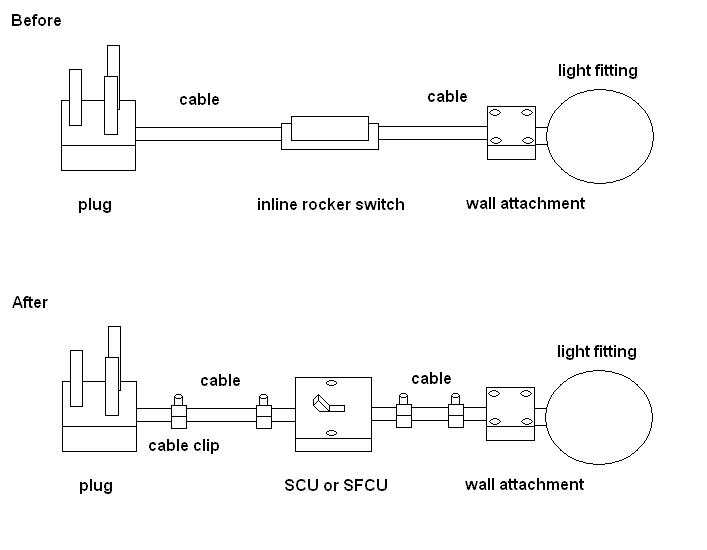* I have a lamp like this one ( http://www.ikea.com/gb/en/catalog/products/00190458/ ), although it may not be that specific one.
* It has a flexible power lead.
* That lead includes an inline rocker on/off switch, and that lead has a 13A UK plug at one end.
* I want to remove the inline rocker on/off switch and replace it with a double-pole single-throw switched connection unit (like this one http://www.diy.com/diy/jsp/bq/nav.jsp?action=detail&fh_secondid=9289780 ), which I can then screw to the wall with a mounting box like this ( http://www.diy.com/diy/jsp/bq/nav.jsp?action=detail&fh_secondid=9289733 ).
* I have read "Approved Document P: Electrical safety - dwellings (2006 edition)" ( http://www.planningportal.gov.uk/uploads/br/BR_PDF_ADP_2006.pdf ), which I believe to be the current and relevant document of the Building Regulations.
* I believe that this work is non-notifiable work within the meaning of Section 0 ("General Guidance"), paragraph 0.7 ("When not necessary to involve building control bodies") of that document.
* I believe that this work is not in a kitchen, or a special location; does not involve work on a special installation; consists of adding light fittings and switches to an existing circuit, and/or adding socket outlets and fused spurs to an existing ring or radial circuit, and/or prefabricated equipment sets and associated flexible leads with integral plug and socket connections; and is therefore included in Table 1 ("Work that need not be notified to building control bodies") of that document.
* I have read the relevant part of the DIYnot wiki ( //www.diynot.com/wiki/electrics:part_p:diy_electrical_work_and_the_law ) and other parts ( //www.diynot.com/network/ericmark/albums/959/11895 ) and I believe it does not contradict my points above.
* I conclude that this work is non-notifiable.
* This posting constitutes a dated public notification of the above.
* It has a flexible power lead.
* That lead includes an inline rocker on/off switch, and that lead has a 13A UK plug at one end.
* I want to remove the inline rocker on/off switch and replace it with a double-pole single-throw switched connection unit (like this one http://www.diy.com/diy/jsp/bq/nav.jsp?action=detail&fh_secondid=9289780 ), which I can then screw to the wall with a mounting box like this ( http://www.diy.com/diy/jsp/bq/nav.jsp?action=detail&fh_secondid=9289733 ).
* I have read "Approved Document P: Electrical safety - dwellings (2006 edition)" ( http://www.planningportal.gov.uk/uploads/br/BR_PDF_ADP_2006.pdf ), which I believe to be the current and relevant document of the Building Regulations.
* I believe that this work is non-notifiable work within the meaning of Section 0 ("General Guidance"), paragraph 0.7 ("When not necessary to involve building control bodies") of that document.
* I believe that this work is not in a kitchen, or a special location; does not involve work on a special installation; consists of adding light fittings and switches to an existing circuit, and/or adding socket outlets and fused spurs to an existing ring or radial circuit, and/or prefabricated equipment sets and associated flexible leads with integral plug and socket connections; and is therefore included in Table 1 ("Work that need not be notified to building control bodies") of that document.
* I have read the relevant part of the DIYnot wiki ( //www.diynot.com/wiki/electrics:part_p:diy_electrical_work_and_the_law ) and other parts ( //www.diynot.com/network/ericmark/albums/959/11895 ) and I believe it does not contradict my points above.
* I conclude that this work is non-notifiable.
* This posting constitutes a dated public notification of the above.



